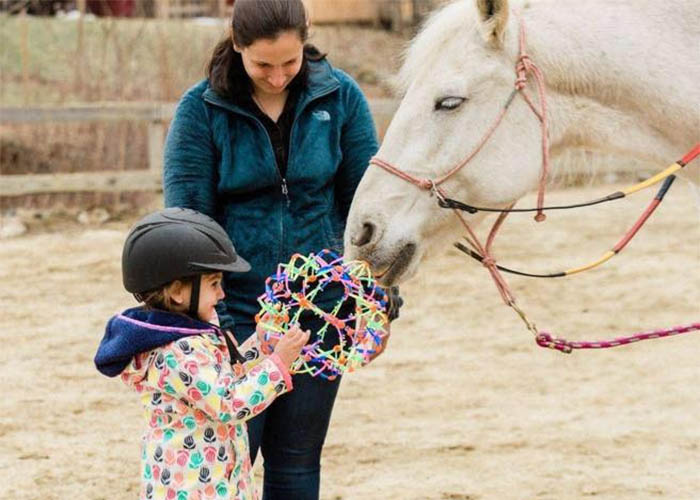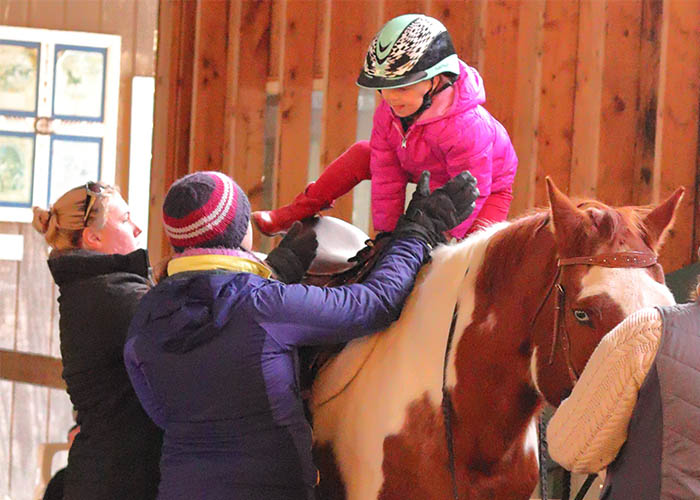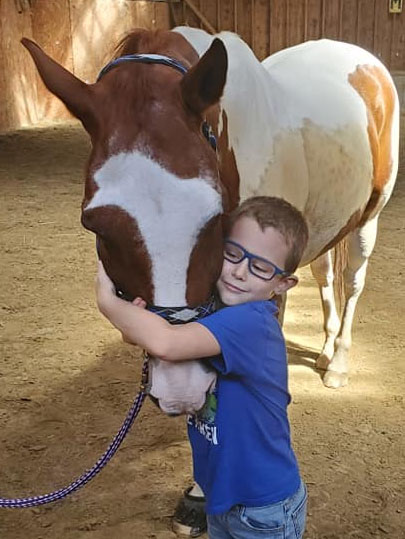
It was once said, “Horses lend us the wings we lack.” While this rings true for every equestrian, it is particularly apparent when you watch the incredible transformations that happen at the True Hope Therapeutic Horsemanship program in Troy, NH, and a new site in Westmoreland, NH, soon. At True Hope, horses and humans come together to provide lessons to participants who are living with one or more of physical, cognitive, emotional, social, or behavioral challenges.
“I wish people knew more about therapeutic riding and the benefits any child or adult may experience,” explains Becki Marrero, the Secretary and Volunteer Coordinator at True Hope Therapeutic Horsemanship. “There really is just something about a horse that can change someone not only physically, but emotionally as well. Our program can benefit someone who has a physical disability that may require assistance from a full team of volunteers or someone who struggles with social and emotional challenges and needs to learn how to interact and build a relationship.”
Saddle Up
True Hope was founded in 2018 and has grown rapidly ever since. The program was started after another popular program in the area closed. The loss of this program in the area was significant, both for the participants and also for the staff and volunteers.
In developing the program at True Hope, the founders and volunteers were able to put a plan in motion. “We focus on making sure that our program horses are well taken care of and loved unconditionally because we believed this would be therapeutic not only for our participants but also for our horses,” Becki says.
The result was an innovative therapeutic lesson program where riders could participate in mounted or unmounted horsemanship lessons with a Professional Association of Therapeutic Horsemanship International (PATH Intl.) certified Instructor based on the needs of the rider and the goals which have been established for them. The instructor screens all participants and sets goals specific to each rider and their individual needs. Depending on the goals and requirements of a rider, they may participate in either unmounted (groundwork activities) or mounted (riding activities).
The participants start each lesson grooming and tacking their horse to the best of their abilities with the help of the instructor or volunteers. Lessons typically consist of rider stretching, horsemanship/riding skills (walk, halt, steering, trot, etc.), navigating obstacle courses, and strengthening the muscles, particularly the core. Riders are also able to help with un-tacking and putting their horse back in their stall after each lesson. “We encourage our riders to build relationships with the horses they work with, starting with a greeting in the horse’s own language as well as with groundwork and natural horsemanship,” Becki explains. “Horses are sentient beings which is what helps create such unique bonds between horses and riders. The horses truly become the teachers for the riders.”

The Power of the Horse
Therapeutic riding is incredibly effective because it takes a well-rounded, whole-body approach.
Physically, riding has been shown to increase muscle strength, coordination, balance, and flexibility. Cognitively, the program helps to improve focus, memory, planning, judgment, and problem-solving skills. Additionally, the relationship between the rider and the horse can increase the self-confidence and self-esteem of the participant, increase trust, develop a sense of empathy, and promote emotional growth and awareness.
“For me personally, I have been lucky enough to witness these lessons in a couple of different roles,” says Becki. “Initially, I was the parent of a child that participated. I watched my young son, who had never been around horses, quickly build a relationship with the biggest horse in the program. He was quick to try new things and offer up suggestions to the other riders in his group, even though he was usually quite shy.” Over the course of his first session, Becki’s son grew from being shy to outgoing and very trusting of his horse. By the last lesson, he was vaulting (a type of therapeutic riding where riders perform movements on the horse, which can be as simple as not holding onto the surcingle). “He always felt so proud of himself when he left the lesson knowing he accomplished something he couldn’t do before,” she continues. “He has said that he finds himself really calm when I just sit on the horse.”
Becki then became a lesson volunteer and began to work hands-on with the horses to help a number of different participants. “Watching riders arrive at the barn for their lessons with big smiles on their faces, excitement in their eyes, and feeling proud of accomplishing their goals are the best parts of this program. It is amazing to watch a child who a parent may describe as hyper or impulsive work with a horse, and they are calm and are very attuned to the horse. When the opportunity arose to get involved and help develop True Hope, I couldn’t wait!”
Get Involved!

There are a number of ways that you can become involved with this powerful therapeutic riding program at True Hope.
Participating In the Program: Any child or adult living with one or more physical, cognitive, social, emotional, or behavioral struggles can become participants. They can ride in private or semi-private (as available) lessons. “I would encourage anyone who thinks they may benefit from this program or knows someone who might, to reach out to us,” says Becki. “We have some very exciting things coming soon that we cannot wait to share!”
Volunteer: The program is always looking for individuals who would like to volunteer. Prospective volunteers must be at least 16 years old, but no horse experience is required, True Hope provides all the necessary training. Volunteers can assist in lessons or other special events. Lesson volunteers are either “leaders” who are responsible for the horse during a lesson which includes leading if necessary or shadowing a rider, “side walkers” who are responsible for the riders during a lesson which includes active side walking (assisting the rider with balance or staying securely in the saddle), or “shadow side walkers” (walking close to the horse but not actively holding the participant). For volunteers who would prefer not to work with horses, they are always looking for help with events and fundraisers.
Donate and Sponsor: This year, True Hope created the Penny Clarke Miracles In Motion Scholarship fund. The scholarship funds raised are used to help riders participate in the program that would not be able to without financial assistance. True Hope works tirelessly to fundraise and find donors to support their program, so they are able to help as many participants as possible.
At The Cheshire Horse, we are proud to highlight this incredible program in our equestrian community. If you have questions about the True Hope program or would like to learn how you can get involved, we encourage you to visit their website or contact them by email at [email protected].

Are you still offering therapeutic riding? I would loved to volunteer to help individuals with challenges benefit from being with horses and/or riding. Look forward to hearing from you.
Hi Sonia, we suggest you visit the True Hope website (www.truehopeth.org) or contact them by email at [email protected] for more information about volunteering.
Yes! True Hope Therapeutic Horsemanship is beginning a new session June 6, 2022 in Fitzwilliam, NH.
VOLUNTEERS NEEDED.
Training provided.
Email:
[email protected]
for more information about True Hope Therapeutic Horsemanship